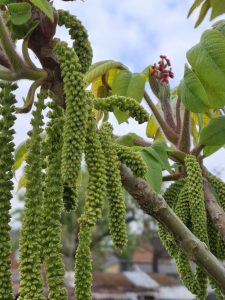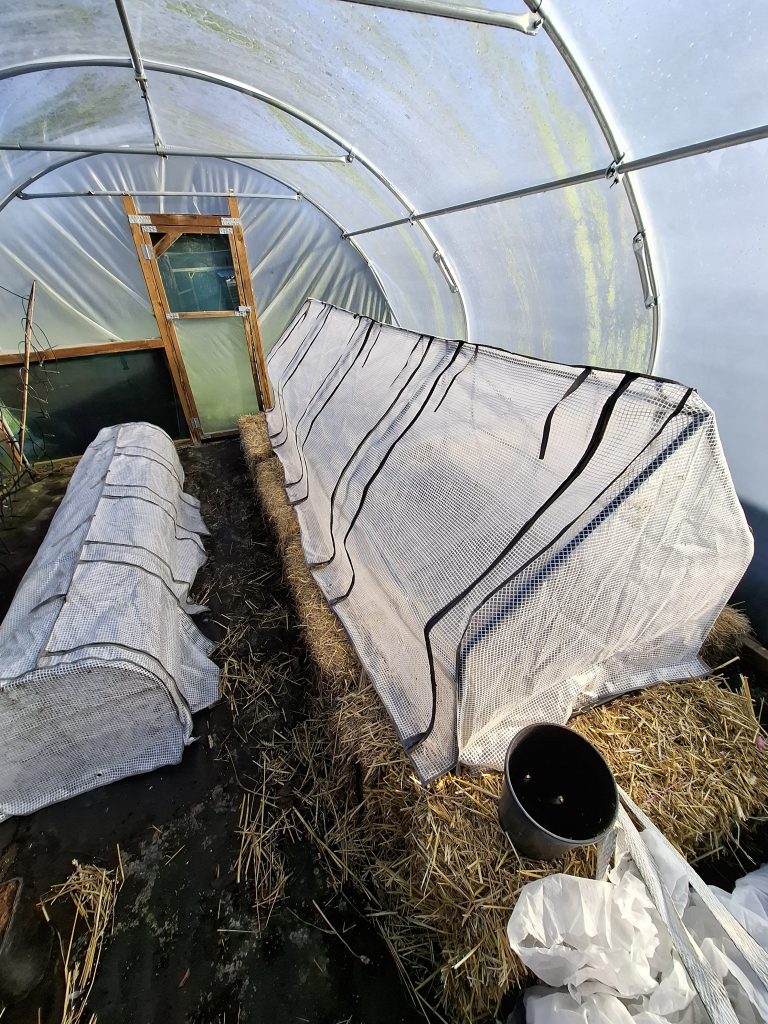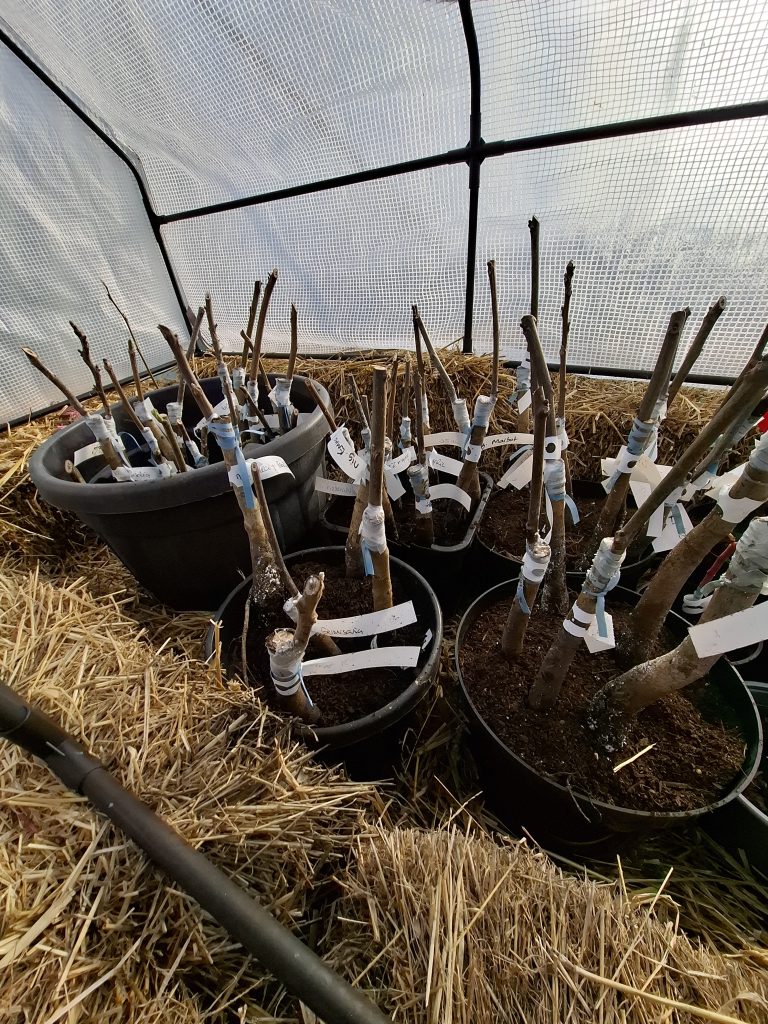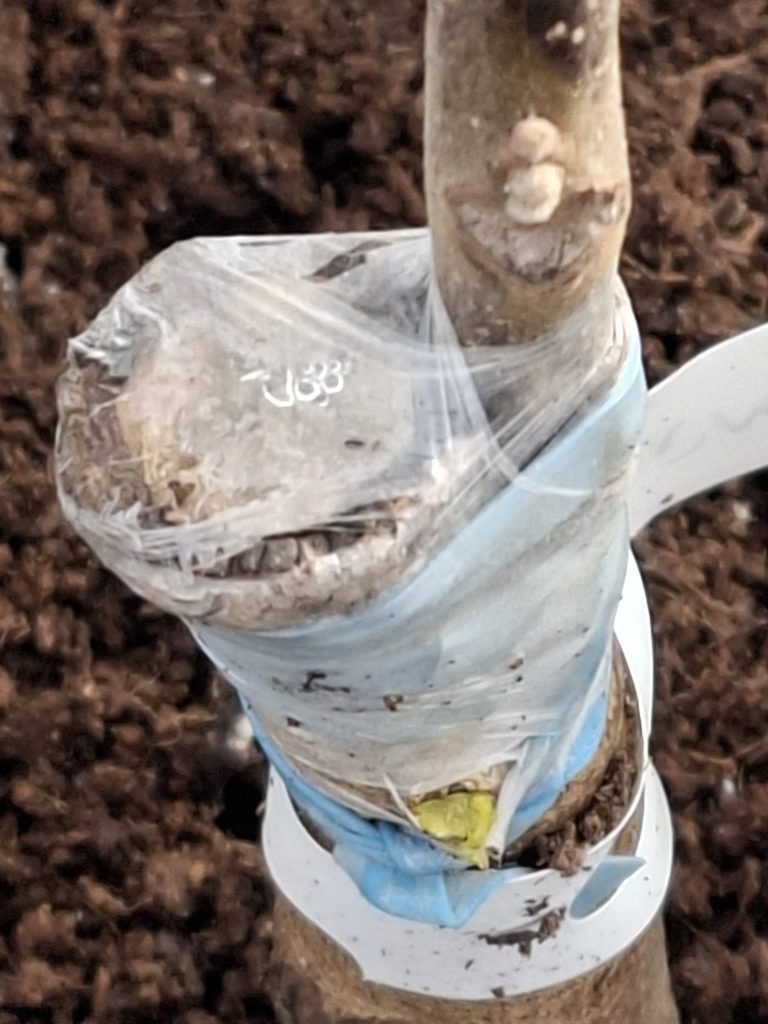As in previous years we’re taking part in the National agroforestry open weekend 2025 we’ll be doing two tours on the 17/18th May, please book a place in advance, details below.
News
Unusual Spring again
Well, following the last two very wet springs this yeas is the polar opposite, until this week we’d had 53mm of rain since December and started irrigating the newly planted trees in March.
Potted trees especially are very susceptible to roots drying out as they’re grown in fast draining commercial composts and although moisture will come in through osmosis most of the time this year there was little to get from the surrounding soil. Bare-root trees are the opposite of this as they have been root pruned and have little fine hair root so need moisture to stimulate root growth, critical when bud break starts.
The actual spring temperatures have been all over the place, upto 20C in March & April and down to around freezing often at night, although very few frosts. This has meant trees in our lower original orchard (86m) have been a bit later in bud break, the mid seasons ones by almost a week although they’ve also accelerated once awake, late ones like Fernor are still tight.
In the new Orchard which is higher (115m) trees have woken up to 7-10 days earlier, they’ve had the warm days but been also warmer at night with the cold further down the slope. This as one of the reasons we picked this field to plant as it wasn’t great for anything other than grass/clover, Lucerne just doesn’t last here as it’s too heavy. We didn’t expect the extra warmth and seasonal advance to be as pronounced though, we’ll see if that’s a regular thing or a one off.
What the lack of frosts this year (all finger and toes crossed still on 26 April) has meant is that all the small heartnuts, black walnuts, Carya etc have had a good uninterupted start, some years our late frosts have caused no end of die back and little growth. All the non J. regia cultivars and Carya are early to mid season bud break (in English walnut terms), none are as late to wake up as the late regia cultivars like Franquette, Fernor etc, probably due to the lack of commercial breeding in all these species.
You might think that walnut species from colder latitudes would be later to bud break but even Manschurica, Ailantifolia, Sigilata collected from colder climates just wake up in our climate all around the same time. Some Heartnuts for example even when listed as ‘latest’ into leaf all seem homogenous here, differences are measured in days, apart from an odd early starter. The image below is of Schubert which is the earliest into leaf and flower, this year there could be some self-fertility as well.

I document all bud break and flowering as often as I’m able even with very young trees, this allows us to build a DB of information to fill in all the very large gaps in information, not just in our country but world wide. Hopefully future plantings will be based on more cerain knowledge than the ‘plant and hope’ method!
Our peculiar maritime climate and a fairly high latitude means we have a lot of seasonal variation affected by the previous summer, winter and then spring each year, no two years are ever the same. All we can say at this stage is that our male pollination is probably more susceptible to seasonal change than the females flowers which seem more consistent regardless of seasonal differences. This has had the effect of us making efforts to source later pollinators for trial here in the hope that we’ll have good coverage as the trees mature. Most information out there is also very anecdotal and site specific so just because a cultivar in Denmark for example is very late doesn’t mean it will continue that pattern in quite the same way here.
Keeping newly grafted trees alive
One of my biggest cares is keeping those new grafted trees alive, most will start to wake up in our hot box grafting system so I try and keep them as close to dormant or held back wherever possible. We get callusing at 12-14 days so once done I get them out and into here.
I don’t want to be heating a greenhouse to keep them alive so I use a mini tunnel in a tunnel, so far extra heating is not required but if it goes to -5C that may change!
I don’t do that many, with some done by another friend I may never have more than 150 to care for at any one time, almost all are of unusual/rare cultivars or species that I’ve sought out for a specific reason so loosing them is very frustrating.



Ton Friesen De Smallekamp
It is with sadness that I have to report the untimely passing of Ton Friesen of De Smallekamp in the Netherlands.
Ton was one of the first people I was lucky to contact when we started searching for different walnuts cultivars to trial here, a friendly postive and helpful man Ton was always very supportive of what we were trying to do here.
He held a Dutch National Collection of Carya but also has a large collection of all juglans and especially Juglans regia cultivars, many of our first trial varieties came from Ton.
Of course we ended up taking lots of Pecans & Hickories as well as all the other walnut species and our trees here are legacy in part to Ton.
As I understand it he was in the process of trying to get Arboretum status for his site to protect it’s genetic legacy from development in the future, as far as I know there is literally no where else in Europe with the range of Carya cultivars and species.
He is survived by his wife Marjolijn who lives in a community on the nursery site.
Radio 4 – Nuts about nuts
We are on ‘On Your Farm’ with Caz Graham this morning 22nd Decemeber 2024
SFI Agroforestry frustrations
Like many others we have been involved with the ELMS Agroforestry trials and kept an eye on the launch of the SFI Agroforestry schemes.
It seemed like it would be of real interest to those of us growing walnuts (and other fruit/nut crops) and provide a real helping hand to get these types of sustainable and profitable crops established.
It’s very disappointing for us that we seem to fall foul of the SFI Agroforestry data layer which was introduced at it’s introduction (Defra loves a map!). I don’t recall this ever being part of the discussion before but now we find all of our current orchards fall outside the Low Sensitivity Area, a field over it’s all roses. How this is calculated is beyond me as there are no discernable differences between literally one side of a road and the other?!
What it means for us is that as the BPS is phased out we have literally nothing to replace it with and despite all the best efforts made to do exactly what everyone keeps telling us do. ie. grow sustainably, sell local and improve the environment. If we fall foul of this how many other farmers find themselves in the same or worse situation.
There is talk of the future SFI Agroforestry schemes for medium/high density being introduced through CS and the possibility of applying then, we all thought CS was going to die a death but apparently not? Our experience of CS with woodland grants any many other aspects is a deeply frustrating one.
As things stand the Low tier payments decreased from what was discussed and the capital costs look uneven for trees compared to guarding for our type of application, I expect Medium and Higher tiers to follow suit, if they ever make the light of day.
Small farms can’t afford to pay Agents to fill out the forms and have to do it themselves and the process just gets more difficult, despite the promises that SFI would be a new dawn with simpler applications and more manageable processes. It’s debatable whether it’s worth all the effort for the small payments even if we were elligible, maybe we’re better off not getting involved and carry on independantly doing our own thing?
In summary it would be good to think that the current agroforestry layout will be subject to some common sense and reform but based on recent history maybe not. The recently reported DEFRA underspend and the apparent lack of understanding of agriculture from today’s politicians and government in general doesn’t inspire confidence.
BBC Midlands today
We appeared on BBC Midlands today last Friday (4 October), there is an News Item on their web site and you can watch the Program Video on YouTube!
Thank you to David Gregory-Kumar and cameraman Paul Hutchins!
New price list
A price list for 2024-25 is now available, more details on the Trees to Buy page.
Nut Rollers
We have always used nut rollers (or Nut Brooms for some) to harvest places a low canopy or small number of trees or where it’s simply too far to take machinery.
In the past there were products of good quality available in the UK, unfortunately that’s no longer the case so we now import German made ones by Feucht Obsttechnik, made by disabled workers.
These are strong and can be filled properly before emptying, the cheap ones look the same but the wires are thinner and fater a third full nuts fall out when trying to add more.
Two versions for walnuts are available, same roller but with either a wooden handle or a telescopic one. They are priced at £69.99 & £79.99 and can be collected from the farm or we can send by carrier. Contact us for more details.
Commercial Walnut Growing Courses
Dates for the next 3 courses have been published on Eventbrite, as before we have funding from the Cotswold National Landscape (formerly AONB) for residents or those working within it.
If you are outside our AONB then you can still attend but contact me first please.
July 22nd 2024, October 28th 2024 & 10th March 2025
